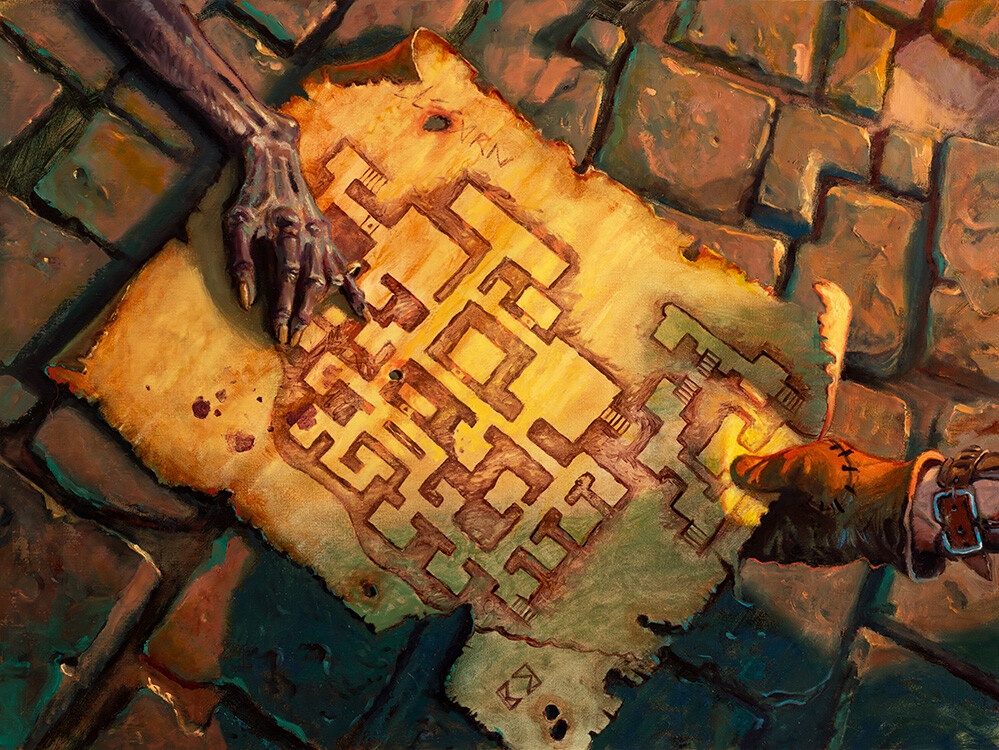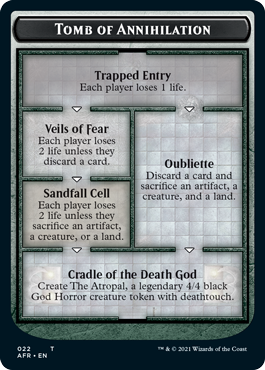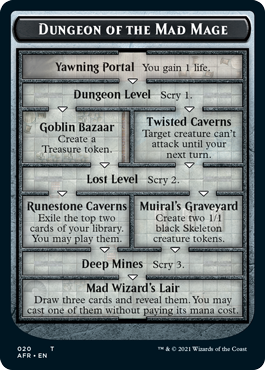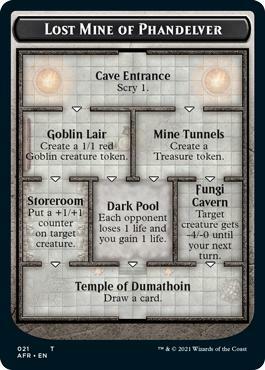Venture into the dungeon is an exciting new mechanic that’s clearly designed with Limited in mind. Before I dive into the nitty gritty, here is a quick description of the mechanic and a look at what the actual dungeons are.
Selecting Your Dungeon In Game
Each dungeon is a little different, and different strategies and battlefields will favor different dungeons.
- Dungeon of the Mad Mage: This dungeon favors long games and is all about value. This is meant for decks that are built around the mechanic or are so controlling that they will see most cards they draft.
- Tomb of Annihilation: This dungeon favors short games. In order to gain a solid advantage from the Tomb, you should be the beatdown in order to take advantage of the loss of life as well as make the 4/4 body a scary reward.
- Lost Mine of Phandelver: This is the default midrange dungeon. It does a little bit of everything. Some battlefield presence. Some life drain. Some fixing. Some card advantage. Some card selection. A non-aggressive deck that isn’t built around the mechanic will very often venture into this dungeon.
The above is the Level 1 way of thinking about it, however it will be a lot more involved. Selecting the dungeon the first time will be incredibly important. For example, I may choose to enter the Dungeon of the Mad Mage because I have a lot of ways to venture into the dungeon in my deck. However, this punishes me because I draw a card that wants me to complete a dungeon, or maybe my opponent plays a one-toughness creature and I wish I could get a 1/1 Goblin. The first time you venture into the dungeon, you’re deciding a subset of options for the future of that game. I’m calling the decisions for navigating dungeons “dungeon pathing”, and I believe doing this properly will be one of the most important aspects of the Limited format.
A Heuristic For Draft Prioritization
Generally, most mechanics have some simple heuristics to help navigate decisions around them. For example, when I teach a person to play the game, I often tell them “when you scry, decide if you need a land or a spell, and then look for that type of card”. A veteran player knows that decisions related to scry are much more nuanced than that, but it can still be helpful to start from somewhere and then build intuition. I believe the following heuristic is a useful place to start for this new mechanic, but will need to be updated significantly over the course of this format.
If you’re drafting, and a card says “venture into the dungeon”, replace that text with all the options from the Nth level of each dungeon, where N is the number of times you believe your deck can reasonably venture into the dungeon. The reason I like this approach is two-fold. First, I think people may over evaluate cards because they think that venturing into the dungeon gets them many effects. It only does this in repetition, which usually requires multiple cards. Hence, when evaluating a single card, it’s best to just look at one branch of the tree rather than the whole thing.
Second, it has a natural threshold. Once you think N is about four, the card will read more insane than any other card and you should take it. I like this because if you believe you can reasonably venture into the dungeon four times in a game, then you can complete dungeons consistently. At that level, your deck is likely to be synergistically built around the mechanic and should highly prioritize cards with it.
Let’s walk through some examples in case the heuristic was too abstract:
In the middle of Pack 3, I see a card that says venture into the dungeon. I only have one other card with the mechanic in my deck, so I think it’s only reasonable I can venture into the dungeon once. Because of this, I evaluate this card as if it said: “choose one: you gain 1 life, each player loses 1 life, or scry 1”.
As another example, let’s say it’s the middle of Pack 2, and I already have four cards that let me venture into the dungeon and one of them is repeatable. While I don’t think I’m a dedicated deck around this mechanic, I think my final build will likely be able to venture three times in each game. So now I can replace the venture into the dungeon text with “choose one: create a Treasure token, target creature can’t attack until your next turn, each player loses 2 life unless they sacrifice an artifact, a creature, or a land, put a +1/+1 counter on target creature, each opponent loses 1 life and you gain 1 life, or target creature gets -4/-0 until your next turn”. While none of those effects are particularly enticing, the sheer number of options makes any card look good.
I’m sure as the format evolves, there will be better shortcuts for thinking about these cards. However, I think what I’ve described above leads you down the right path and I intend on considering cards this way for the first week.





